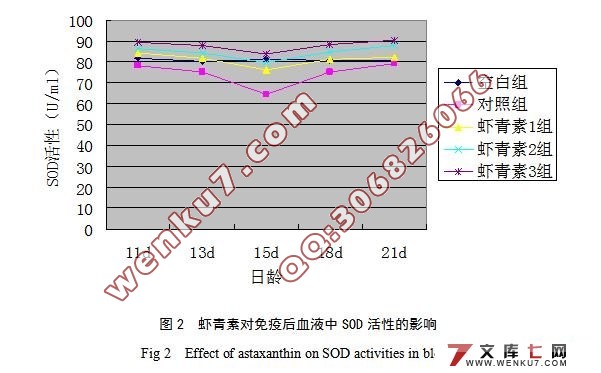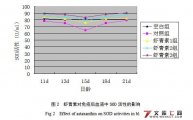虾青素对鸡新城疫II系苗免疫应激时血液生化指标影响
来源:wenku7.com 资料编号:WK78029 资料等级:★★★★★ %E8%B5%84%E6%96%99%E7%BC%96%E5%8F%B7%EF%BC%9AWK78029
以下是资料介绍,如需要完整的请充值下载。
1.无需注册登录,支付后按照提示操作即可获取该资料.
2.资料以网页介绍的为准,下载后不会有水印.资料仅供学习参考之用. 密 保 惠 帮助
资料介绍
虾青素对鸡新城疫II系苗免疫应激时血液生化指标影响(9600字)
摘 要:目的: 虾青素对鸡新城疫II系苗免疫应激时血液生化指标影响。方法: 一定数量的AA肉鸡分为五组,免疫后供给含有不同含量虾青素的饲料,饲喂一定时间后,处死采血进行相关血液生化指标(SOD,GSH-Px,白蛋白,总蛋白,溶菌酶的含量)的检测,并记录相应的生长指标。结果表明:虾青素对鸡新城疫II系苗免疫应激具有能减少免疫应激反应,显著提高肉鸡日增重,提高血清中超氧化物歧化酶、白蛋白、总蛋白及溶菌酶的含量。
关键词:疫苗免疫应激;鸡新城疫II系苗;虾青素;生化指标;
Effect of Astaxanthin on Department of Blood Biochemical Indicators for Newcastle disease vaccination Stress II
Abstract: Objective: The effect of Astaxanthin on Department of Blood Biochemical Indicators for Newcastle disease vaccination Stress II. Methods: 125 AA broilers were divided into five groups, after immunization, supply with different levels of astaxanthin, after a certain time, executing and taking the blood, then check the related blood biochemical parameters(the content of SOD, GSH-PX, albumin, total protein,lysozgme), at last record the corresponding growth index.. The results showed: Astaxanthin could finally led to the decrease of immunological stress response Moreover, it could cause the increase of daily gain for broilers. and concentration of lysozyme in seraduring vaccination of Newcastle disease vaccine II.
Key words: immunological stress of vaccine; Newcastle disease vaccine II;astaxanthin;Bioch- emical parameters;

目 录
摘要……………………………………………………………………………………1
关键词…………………………………………………………………………………1
1 前言…………………………………………………………………………………2
1.1 应激、免疫应激…………………………………………………………………2
1.2疫苗免疫应激及其危害……………………………………………………………2
1.3 虾青素的来源、功能及应用………………………………………………………3
2 材料与方法…………………………………………………………………………5
2.1 材料………………………………………………………………………………5
2.1.1 实验动物………………………………………………………………………5
2.1.2 实验动物仪器…………………………………………………………………5
2.2 方法………………………………………………………………………………… 5
2.2.1实验设计…………………………………………………………………………5
2.2.2饲养管理…………………………………………………………………………6
2.2.3血液采集和生理生化指标的检测………………………………………………6
2.2.4 体重、日增重的测定……………………………………………………………6
2.3统计分析……………………………………………………………………………6
3.结果…………………………………………………………………………………6
4讨论…………………………………………………………………………………11
5.结论………………………………………………………………………………12
参考文献………………………………………………………………………………12
致谢……………………………………………………………………………………14
|



